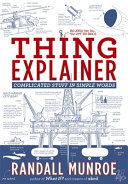Part 1
The Thing Explainer: Building the World with Simple Words
Imagine you're trying to explain how a spaceship works to someone who only knows a few hundred words – words like "box," "stick," "push," and "big." That's the challenge Randall Munroe sets himself in "The Thing Explainer." He takes complex machines and processes, things like the International Space Station or the human body, and explains them using only the 1,000 most common words in the English language. The result is incredibly clever and surprisingly insightful.
Let's start with something familiar: a bicycle. You know what a bicycle is, right? Two wheels, a seat, handlebars, and pedals. But how does it *work*? Munroe would break it down like this: It's a big metal box (the frame) with two round things (wheels) that spin. You push on sticks (pedals) that make a stick (chain) turn a bigger stick (gears) connected to the round things (wheels). This makes the round things (wheels) spin, and the big metal box (frame) moves. Simple, right? But it captures the essence. He doesn't use words like "transmission," "sprockets," or "torque" because those words are beyond his self-imposed vocabulary limit.
Now let's think bigger. The International Space Station (ISS). This isn't just a bicycle; it's a giant, floating city in space! Munroe uses his simple vocabulary to explain its incredible complexity. Imagine it as a bunch of big metal boxes (modules) stuck together. These boxes have lots of little boxes (equipment) inside that keep the people inside alive. There are big sticks (solar panels) that catch the sun's light and turn it into power, like tiny suns powering the big metal boxes. To move around, the ISS uses big push things (rocket engines) that fire gas out the back, pushing it forward. It's all about pushing and pulling, spinning and sticking things together.
The book also dives into the human body. Your body is a giant, complex machine, even more amazing than a spaceship! Your heart is a pump, a big muscle that pushes a red liquid (blood) around your body through many tiny tubes (blood vessels). Your lungs are big bags that take in air (to get oxygen) and let out air (to get rid of carbon dioxide). Your brain is a big, soft, squishy thing that controls everything. It's like a supercomputer made of jelly, sending messages to all parts of your body through tiny wires (nerves). These nerves tell your muscles what to do, whether it's walking, talking, or even thinking.
What about something more abstract, like the internet? Munroe explains it as a giant network of connected boxes (computers) that can talk to each other. These boxes share information using light pulses sent through thin glass tubes (fiber optic cables) that travel across the world. It's like a massive, global telephone system, but instead of voices, it carries pictures, videos, and all sorts of information.
He also tackles seemingly simple things and reveals surprising complexity. A simple zipper, for example, involves interlocking teeth that slide past each other. The seemingly simple act relies on precise engineering and design to work smoothly.
Even something as basic as a pencil is explained in a way that highlights the ingenuity of its design. A long stick (graphite) inside a wooden box (the casing) allows us to leave marks on paper. The simplicity of the explanation makes the cleverness of the design stand out.
By using only simple words, Munroe forces us to focus on the fundamental mechanisms at play. It's a refreshing change from overly technical explanations. It helps us understand the underlying principles, rather than getting lost in the jargon.
Lesson
Even the most complex things can be understood if you break them down into their basic components and explain them using simple language. Focusing on the core principles helps us appreciate the ingenuity and wonder of how things work. The complexity often hides the beauty of the basic ideas.
